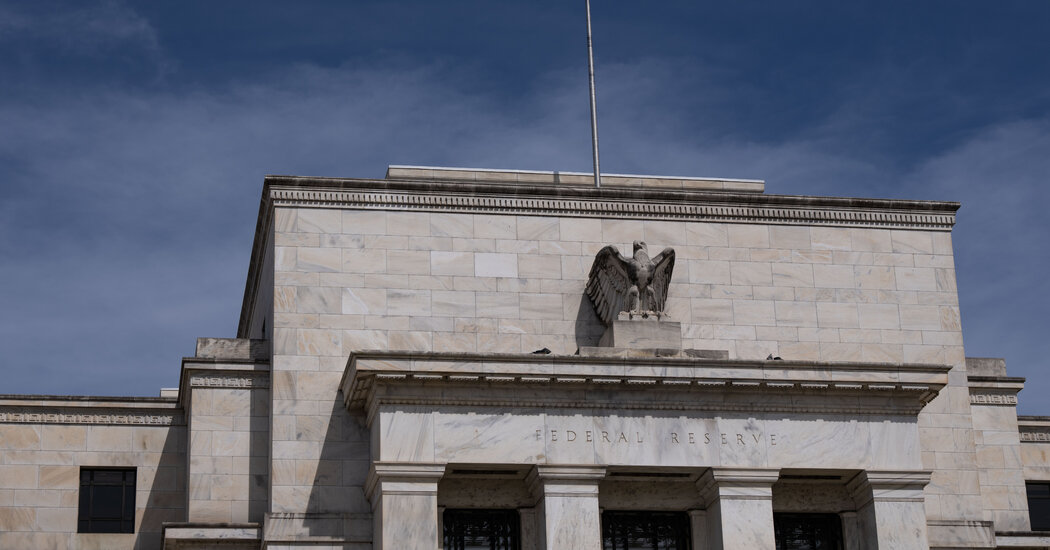February 25, 2024 | by Kaju

Federal Reserve officers welcomed a current inflation slowdown at their final assembly in late January however had been intent on continuing fastidiously as they tiptoe towards fee cuts, in response to minutes from that gathering, which had been launched on Wednesday.
Central bankers raised rates of interest sharply from March 2022 to July 2023, pushing them to five.3 p.c from a place to begin close to zero. These strikes had been meant to chill client and enterprise demand, which officers hoped would overwhelm speedy inflation.
Now, inflation is slowing meaningfully. Client costs climbed 3.1 p.c within the 12 months by way of January, down sharply from their current peak of 9.1 p.c. However that’s nonetheless quicker than the tempo that was regular earlier than the pandemic, and it’s above the central financial institution’s objective: The Fed goals for two p.c inflation over time utilizing a special however associated metric, the Private Consumption Expenditures index.
The financial system has continued to develop at a stable clip whilst value development has moderated. Hiring has remained stronger than anticipated, wage development is chugging alongside and retail gross sales information have instructed that buyers are nonetheless keen to spend.
That mixture leaves Fed officers considering when — and the way a lot — to decrease rates of interest. Whereas central bankers have been clear that they don’t suppose they should elevate borrowing prices additional at a time when inflation is moderating, they’ve additionally instructed that they’re in no hurry to chop charges.
“There had been vital progress not too long ago on inflation returning to the committee’s longer-run objective,” Fed officers reiterated of their freshly launched minutes. Officers thought that cooler hire costs, bettering labor provide and productiveness beneficial properties may all assist inflation to average additional this 12 months. Policymakers additionally instructed that “upside dangers to inflation” had “diminished” — suggesting that they’re changing into extra assured that inflation is coming down sustainably.
However in addition they recognized dangers that would pull inflation greater. Specifically, “contributors famous that momentum in mixture demand could also be stronger than at present assessed, particularly in gentle of surprisingly resilient client spending final 12 months.”
When policymakers final launched financial projections in December, their forecasts instructed that they may make three quarter-point fee cuts this 12 months, to about 4.6 p.c. Buyers are now betting that charges will end 2024 at round 4.4 p.c, although there’s some feeling that they may find yourself barely greater or decrease.
As they consider the way forward for coverage, Fed policymakers should steadiness competing dangers.
Leaving rates of interest too excessive for too lengthy would danger slowing development greater than officers need — a priority that “a pair” of officers raised on the Fed’s late January assembly. Overly tight coverage may push unemployment greater and will even spur a recession.
However, slicing charges prematurely may recommend to markets and on a regular basis People that the Fed is just not critical about crushing inflation till it’s absolutely again to regular. If value will increase had been to choose up once more, they might be even more durable to crush down the highway.
“Most contributors famous the dangers of transferring too rapidly to ease the stance of coverage,” the minutes stated.
Policymakers are additionally considering when to cease shrinking their steadiness sheet of bond holdings so quickly.
Officers purchased a lot of Treasury and mortgage-backed debt throughout the pandemic, first to appease troubled markets and later to stimulate the financial system by making even longer-term borrowing cheaper. That swelled the dimensions of the Fed steadiness sheet. To scale back these holdings to a extra regular stage, officers have been permitting securities to mature with out reinvesting the proceeds.
However central bankers need to transfer fastidiously: In the event that they regulate the steadiness sheet too rapidly or an excessive amount of, they danger upsetting the plumbing of monetary markets. Actually, that occurred in 2019 after the same course of.
Policymakers determined at their assembly that “it will be acceptable” to start in-depth discussions of the steadiness sheet on the Fed’s subsequent assembly, which can happen in March — with some suggesting that it may be helpful to sluggish the tempo of the shrinking and that doing so “may enable the committee to proceed steadiness sheet runoff for longer.”
RELATED POSTS
View all


